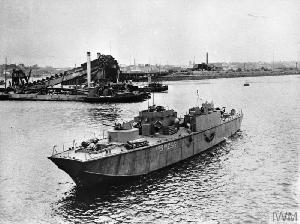Heslop's Local Advertiser
Newcastle Evening Chronicle 19/01/1945
Newcastle Evening Chronicle Thursday 18/01/1945
Newcastle Evening Chronicle Thursday 1/11/1945

LCS (L) 256 Photo : IWM Ref FL 5827
His death was reported in Heslop's Local Advertiser:
"16/11/1946 Hopkins - Felling. Frederick D., killed in action Nov. 1, 1944. Royal Marines."
The edition of 15/11/1947 carried the same wording.
LCS (L) 256 was part of the Inshore Support Squadron Eastern Flank which protected the Eastern flank of the Normandy beachhead Anchorage commonly known as the Trout Line.
LCS(L) No.252, 256, 258, "Landing craft support (Large) (MkII) (total 3, 112t each) lost in Operation Infatuate, Walcheren Landings, Holland, November 1, 1944.
LCS(L)256 built John Sadd, Maldon 1943. 1943 sunk 1/11/1944
This Division (LCS(L) 252, 256 and 258) were in the Southern Group and accompanying LCG(M) 102 towards the shore when 252 was hit by a salvo from the Zoutelande Battery (W13), set on fire, blew up and sank. 256 was also hit and set on fire. 258 drew alongside to rescue survivors, was hit and set on fire too. The order to abandon ship was given and shortly afterwards both craft blew up and sank.
Operation Infatuate
The force sailed from Ostend at 03:15 hours and by 09:30 hours they were off the objective. The ships bombarded the German defences with everything at their disposalincluding the 15-inch (380 mm) guns of HMS Warspite, Erebus and Roberts, the Landing Craft (Gun)s, the rockets of LCT(R)s. The first German fire at 8:09 was followedby the other batteries. Most of the German fire was concentrated on the support landing craft rather than those carrying the troops. Several landing craft werehit including a rocket LCT which received a direct hit. The RAF was able to provide a squadron (No. 183 Squadron) of explosive rocket-firing Typhoon fighter-bombersjust at the point the LCTs were due to land.
Part of the naval Support Squadron of 27 small craft, under Commanders Sellar and Leefe, closed to engage the eleven still-operational German shore-based batteries,on the direction of Captain A.F. Pugsley, R.N., DSO, the naval commander of the amphibious landings. This they did with conspicuous gallantry, but with very heavycasualties.
By 12.30pm, nine of the Support Squadron's craft had been sunk, eleven put out of action, and a high percentage of their crews killed or wounded.
Ultimately the Support Squadron was recalled as so many of the craft had been damaged or destroyed, but their aim, of drawing the fire of the defending batteriesfrom the landing craft making the primary assault, had succeeded.
Royal Marine Commandos landing at Walcheren using DUKW's, LVT, LCT's and Buffalo amphibians on the 1st November 1944.
In a tribute to the bravery of the Support Squadron, General Laycock, Chief of Combined Operations, wrote to Captain A.F. Pugsley with the following words:
"I understand that the success of the landings and the comparatively light casualties sustained by No. 4 Special Service Brigade at Walcheren was due largely to the heroic efforts of the Naval Support Craft who, at great cost to themselves, effectively silenced the coastal defences. I should like to express the appreciation of all ranks, Special Service Group, and particularly that of General Sturges and Brigadier Leicester and all ranks of No. 4 Special ServiceBrigade for the self-sacrifice shown by all naval personnel during the landings, which had such splendid results."
The naval haul of gallantry awards was significant. Of particular note were the actions of Leading Seaman Owen Joseph McGrath who was Coxswain of a LandingCraft (LCP(L) 144) during the assault on Westkapelle. McGrath's citation for the Conspicuous Gallantry Medal (the highest award for gallantry available tonon-commissioned naval personnel short of the Victoria Cross) reads as follows: "[LCP(L) 144's] duty was to make smoke on the Southern flank. Many craft werehit by the accurate enemy fire, and some blew up very close inshore under the enemy guns. LCP(L) 144 was ordered to close, make smoke and pick up survivors.This was done at point blank range with an off-shore wind making effective smoke difficult. By his courageous action Leading Seaman McGrath rescued over twentysurvivors".
Source : Operation Infatuate Official despatches.
Operation Infatuate
Naval History losses
The CWGC entry for Marine Hopkins

